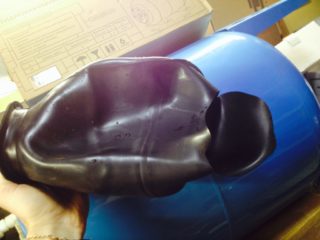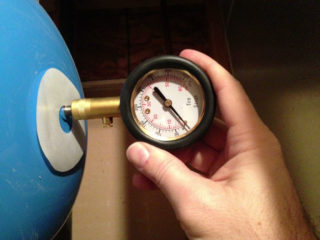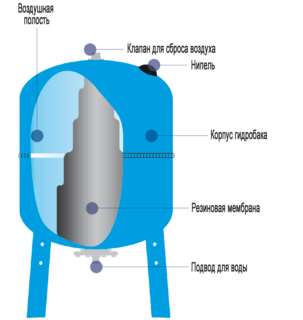To save on energy consumption and to eliminate pressure fluctuations in pumping units with hydraulic accumulators, a special separating element is used - a membrane. For long-term and trouble-free operation of the equipment, it is important to know the design characteristics and rules for the operation of this part.
Purpose and principle of operation
- Water is pumped into the membrane bag, and the air between it and the walls of the device is compressed.
- When the maximum allowable pressure is reached - for household devices it is 1.8–3 atmospheres - the pump will turn off. The value must first be set on the pressure switch.
- The liquid enters the water consumers with the required pressure due to the action created by the compressed air, which is located inside the accumulator.
- After reducing the pressure to the lowest value, the pump will automatically turn on to collect water.
Such a scheme allows you to eliminate drops in the water pressure and ensure the stable operation of the system. The consumption of electricity is saved and the period of operation of the equipment is increased, since the pump is turned on much less frequently. The use of a hydraulic tank with a membrane in the water supply network is also good in that it minimizes the sudden pressure drops that occur when starting the pumping unit.
Varieties and selection criteria
Parts that look like a medical heating pad are installed in small accumulators - no more than 100 liters. In large hydraulic tanks - over 100 liters - the diaphragms are similar in shape to a bottle or a pear. All these options in terms of volume can be flat or balloon. The principle of operation is similar for different types.
When choosing a membrane, it is also taken into account that the products differ in the purpose of the hydraulic tank:
| Characteristics | For water supply | For heating |
| Color | White | The black |
| Manufacturing material | Natural or bottled rubber | Temperature resistant EPDM or SBR rubber |
| Temperature range (° C) | from 0 to 70 | from -10 to 99 |
| Maximum pressure (bar) | 7 | 8 |
Rubber is less resistant to low and high temperatures, but it is immune to the action of bacteria, mold and mildew. These properties are important for maintaining the quality of drinking water. Under no circumstances should tanks with SBR diaphragms be used for connection to water mains. Styrene-butadiene rubber is a non-food material. It can be used exclusively in liquid reservoirs for technical use.
There are other ways to classify membranes for hydraulic tanks that should be considered when choosing.
By size
Dimensional indicators are very important: in case of an error, a worn part cannot be replaced with a new one. The assessment takes into account the following criteria:
| Capacity (l) | Dimensions (mm) | ||
| Flange size (inner / outer) | Length | Cross section | |
| 0,16 | 45/65 | 65 | 58 |
| 2–3 | 45/65 | 135 | 80 |
| 5–8 | 45/65 | 155 | 105 |
| 8–12 | 45/65 | 200 | 115 |
| 12–18 | 45/65 | 265 | 135 |
| 24 | 80/110 or 90/120 | 260 | 200 |
These indicators must be indicated in the technical documentation for the hydraulic accumulator.
It is also important to consider the mounting of the diaphragm. It usually takes place at the bottom of the tank through a flange. But in volumetric devices, called pass-throughs, mounting from above is also provided. A hollow rod with a sealing element on one end and a thread on the other passes through a hole in the upper part of the membrane.The threaded end is led out of the tank and attracted to the latter by a nut. In fact, the outer part is a threaded nipple that can be simply plugged or fitted with a pressure switch and / or pressure gauge.
By replaceability
Manufacturers produce two types of expansion membrane units - with a replaceable and with a stationary diaphragm. The former are more expensive, but they can replace the element in a timely manner if gaps occur or it is deformed. The latter are inexpensive. But in this case, the replacement of damaged parts and the resumption of the work of the water supply system are not provided.
It is rational to give preference to the first type of accumulators. Otherwise, the device will work as long as the diaphragm can withstand.
Replacing a worn part is easy, you can do it yourself, prices for rubber parts are relatively low. They depend on the volume of the element, the material of manufacture and the manufacturer. Prices for the Jilex membrane for a hydraulic accumulator start at 600 rubles, the most inexpensive replacement parts for Aquasystem cost from 260 rubles, and Reflex - from 1100 rubles.
Features of installation when replacing

The diaphragm in the hydraulic accumulator is a consumable element. Over time, it becomes unusable, and replacement is required, if the design of the device provides for this possibility. The part wears out due to uneven pressure in the system, with continuous compressions and stretches, friction against other elements. Systematic and sharp temperature drops, excess pressure indicators also do not contribute to an increase in the service life. According to the statements of manufacturing companies, it averages five years, but the impact of negative factors is difficult to avoid. In fact, the membrane lasts three years at best.
How to determine that a rubber bulb for a hydraulic accumulator requires replacement:
- the pump fails, there are frequent starts and stops;
- pressure gauge readings are jumping;
- nipple leaks;
- water from the tap comes in intermittent streams;
- there is a leak behind the air valve.
In all these malfunctions, in most cases, diaphragm wear is to blame, but sometimes there are breakdowns in the case. Before replacing the membrane, check it for defects.
To change the diaphragm, it is first necessary to turn off the power supply and release the pressure in the system, as well as drain the remaining water from the hydraulic tank.
The next steps are as follows:
- Unscrew the bolts, remove the flange and remove the damaged diaphragm from the special hole in the lower part of the body.
- Inspect the tank for integrity, dirt and corrosion. Rinse and dry.
- Install the replacement part.
- Screw the flange into place, pump air to 1.4 atmospheres.
Then they connect the power supply and water, check the operation of the system. After carrying out all the manipulations, the battery is ready for use.
It should be noted that products from different manufacturers are not interchangeable. They differ in size.
You can change the diaphragm with your own hands and without contacting a specialist. But only if all the norms and requirements of assembly or disassembly are observed, it is possible to carry out work at the level of professionals. If replacement is impossible, the torn membrane is sealed with special glue or vulcanized. This will extend the life of the element, but soon it will still have to be changed. However, repairs will extend the life of the fixed diaphragm instrument.
Operating rules

In order for the diaphragm of the hydraulic tank and the device itself to serve for a long time, you must adhere to the following recommendations:
- Inspect and check the battery monthly to ensure it meets the specifications. The latter are individual for each drive model.
- If you are not using the hydraulic tank, keep it in a dry place, avoiding contact with heaters. Otherwise, the material of the diaphragm may become dry, leading to its destruction.
- Check for corrosion and leaks at the joints and on the body of the hydraulic accumulator.
- Periodically measure the air pressure in the product and check its stability.
- Check the integrity of the diaphragm about every six months.
In the event of a malfunction of the device, immediate troubleshooting is required to avoid aggravating the situation. Otherwise, you can bring the device to a state beyond repair.
When operating a pressure device with a hydraulic accumulator without a diaphragm, the load increases and wear accelerates. The pump constantly turns on when the tap is opened. This increases energy consumption and risks of water hammer. A high-quality diaphragm will help keep your equipment out of these troubles.









